-
 Bitcoin
Bitcoin $101,898.5005
-0.75% -
 Ethereum
Ethereum $2,258.1125
-1.07% -
 Tether USDt
Tether USDt $1.0004
0.01% -
 XRP
XRP $2.0178
-2.93% -
 BNB
BNB $624.0243
-1.53% -
 Solana
Solana $134.3298
-0.90% -
 USDC
USDC $0.9999
0.01% -
 TRON
TRON $0.2675
-2.05% -
 Dogecoin
Dogecoin $0.1538
-1.96% -
 Cardano
Cardano $0.5482
-1.11% -
 Hyperliquid
Hyperliquid $35.5636
5.45% -
 Bitcoin Cash
Bitcoin Cash $453.4902
-1.66% -
 Sui
Sui $2.5134
-2.97% -
 UNUS SED LEO
UNUS SED LEO $9.1292
1.77% -
 Chainlink
Chainlink $11.8457
-1.60% -
 Stellar
Stellar $0.2312
-2.73% -
 Avalanche
Avalanche $16.9721
0.29% -
 Toncoin
Toncoin $2.7549
-3.82% -
 Shiba Inu
Shiba Inu $0.0...01081
-1.10% -
 Litecoin
Litecoin $80.8250
-0.71% -
 Hedera
Hedera $0.1374
0.21% -
 Monero
Monero $305.4827
-2.36% -
 Ethena USDe
Ethena USDe $1.0006
0.00% -
 Dai
Dai $1.0000
-0.01% -
 Polkadot
Polkadot $3.2085
-3.12% -
 Bitget Token
Bitget Token $4.0845
-3.13% -
 Uniswap
Uniswap $6.3353
-1.63% -
 Pi
Pi $0.5085
-0.70% -
 Pepe
Pepe $0.0...08913
-3.82% -
 Aave
Aave $232.7090
-0.58%
How to analyze the divergence between MA and price? Is it a reversal signal?
Divergence between price and Moving Averages can signal potential reversals; traders should use additional indicators for confirmation to increase prediction reliability.
May 24, 2025 at 03:42 am
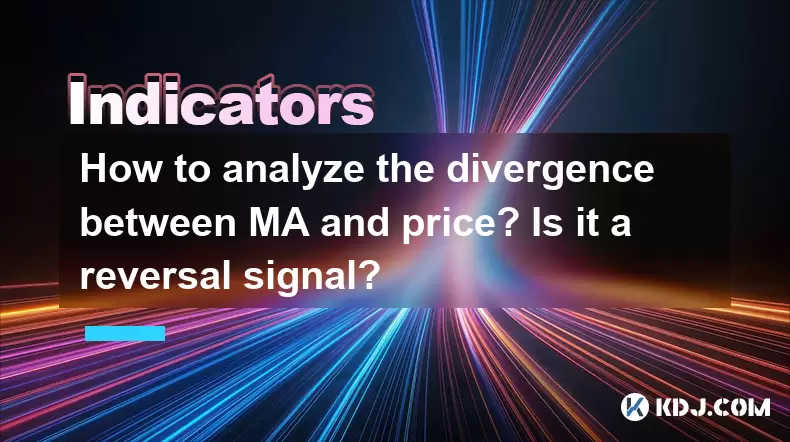
Analyzing the divergence between Moving Averages (MA) and price is a crucial technique used by many cryptocurrency traders to identify potential reversal signals. Divergence occurs when the price of an asset moves in the opposite direction of a technical indicator, such as a Moving Average. This article will explore how to analyze this divergence, whether it signals a potential reversal, and how traders can use this information to make informed decisions.
Understanding Moving Averages
Before diving into the divergence analysis, it's essential to understand what Moving Averages are. Moving Averages are trend-following indicators that smooth out price data to create a single flowing line, making it easier to identify the direction of the trend. There are several types of MAs, but the most commonly used are the Simple Moving Average (SMA) and the Exponential Moving Average (EMA). The SMA calculates the average price over a specific period, while the EMA gives more weight to recent prices, making it more responsive to new information.
Identifying Divergence
Divergence between the price and a Moving Average occurs when the price moves in one direction while the MA moves in the opposite direction. There are two types of divergence: bullish divergence and bearish divergence. Bullish divergence happens when the price makes a lower low, but the MA makes a higher low, indicating that the downward momentum is weakening. Conversely, bearish divergence occurs when the price makes a higher high, but the MA makes a lower high, suggesting that the upward momentum is fading.
Analyzing Bullish Divergence
To analyze bullish divergence, follow these steps:
- Identify the lower lows in the price: Look for a series of lower lows on the price chart.
- Check the Moving Average: Ensure that the MA is making higher lows during the same period.
- Confirm the divergence: The difference between the price lows and the MA lows should be significant enough to suggest a weakening downtrend.
When bullish divergence is present, it can be a sign that the price may soon reverse and start moving upwards. This is because the weakening downward momentum indicates that sellers are losing control, and buyers might soon take over.
Analyzing Bearish Divergence
To analyze bearish divergence, follow these steps:
- Identify the higher highs in the price: Look for a series of higher highs on the price chart.
- Check the Moving Average: Ensure that the MA is making lower highs during the same period.
- Confirm the divergence: The difference between the price highs and the MA highs should be significant enough to suggest a weakening uptrend.
When bearish divergence is present, it can be a sign that the price may soon reverse and start moving downwards. This is because the weakening upward momentum indicates that buyers are losing control, and sellers might soon take over.
Is Divergence a Reversal Signal?
Divergence between the price and a Moving Average can indeed be a strong indicator of a potential reversal. However, it is not a foolproof signal, and traders should use it in conjunction with other technical analysis tools to increase the reliability of their predictions.
- Use additional indicators: Combine divergence analysis with other indicators such as the Relative Strength Index (RSI) or the Moving Average Convergence Divergence (MACD) to confirm potential reversals.
- Look for price patterns: Identify common reversal patterns like head and shoulders, double tops, or double bottoms to support the divergence signal.
- Consider volume: High trading volume during the divergence can reinforce the likelihood of a reversal, as it indicates increased interest in the asset.
Practical Example of Divergence Analysis
Let's consider a practical example to illustrate how to analyze divergence between the price and a Moving Average. Suppose we are analyzing the price of Bitcoin (BTC) using a 50-day SMA.
- Step 1: Plot the 50-day SMA on the BTC price chart.
- Step 2: Identify a period where the price of BTC is making lower lows, but the 50-day SMA is making higher lows.
- Step 3: Confirm the bullish divergence by ensuring the difference between the price lows and the SMA lows is significant.
- Step 4: Use additional indicators like RSI to confirm the potential reversal.
- Step 5: Monitor the price action closely, looking for a breakout above a key resistance level to confirm the reversal.
In this example, if the bullish divergence is confirmed and other indicators support a potential reversal, traders might consider entering a long position, anticipating that the price of BTC will start to rise.
Common Mistakes to Avoid
When analyzing divergence between the price and a Moving Average, it's important to avoid common mistakes that can lead to incorrect interpretations:
- Ignoring the time frame: Divergence signals can vary significantly across different time frames. Always consider the time frame you are trading on and look for divergence signals that align with your trading strategy.
- Overlooking false signals: Not all divergence signals lead to a reversal. Sometimes, the price may continue in its original direction despite the divergence. Always use additional confirmation tools to increase the reliability of your analysis.
- Neglecting market context: The broader market context, including news and events, can influence the effectiveness of divergence signals. Always consider the overall market environment when interpreting divergence.
Frequently Asked Questions
Q: Can divergence be used on any time frame?
A: Yes, divergence can be analyzed on any time frame, from short-term charts like 1-minute or 5-minute charts to long-term charts like daily or weekly charts. However, the significance and reliability of divergence signals can vary depending on the time frame. Short-term divergences may lead to smaller price movements, while long-term divergences can signal more significant reversals.
Q: How often should I check for divergence signals?
A: The frequency of checking for divergence signals depends on your trading style. Day traders might check for divergence signals multiple times throughout the day, while swing traders might check on a daily or weekly basis. It's important to align your divergence analysis with your trading strategy and time frame.
Q: Can divergence be used with other types of Moving Averages?
A: Yes, divergence can be analyzed using various types of Moving Averages, including Simple Moving Averages (SMA), Exponential Moving Averages (EMA), and Weighted Moving Averages (WMA). Each type of MA may provide different insights, so it's beneficial to experiment with different MAs to find what works best for your trading strategy.
Q: Is divergence analysis more effective in certain market conditions?
A: Divergence analysis can be effective in various market conditions, but it tends to be more reliable in trending markets. In a strong uptrend or downtrend, divergence signals can help identify potential reversals. However, in a ranging or choppy market, divergence signals may be less reliable and more prone to false positives. Always consider the overall market context when interpreting divergence signals.
Disclaimer:info@kdj.com
The information provided is not trading advice. kdj.com does not assume any responsibility for any investments made based on the information provided in this article. Cryptocurrencies are highly volatile and it is highly recommended that you invest with caution after thorough research!
If you believe that the content used on this website infringes your copyright, please contact us immediately (info@kdj.com) and we will delete it promptly.
- BNB Price Check: Stablecoin Surge vs. Prediction Rollercoaster
- 2025-06-23 14:25:12
- Metaplanet's Bitcoin Bonanza: Holdings Skyrocket Amidst Market Swings
- 2025-06-23 14:25:12
- Global Meltdown, Investors, and Safe Havens: Navigating the Storm
- 2025-06-23 14:30:12
- NFT Sales Snapshot: Guild of Heroes, Polygon, and the Market's Shifting Sands
- 2025-06-23 15:25:12
- AVAX Support Holds, Eyes Potential Surge: What's Next?
- 2025-06-23 15:11:16
- Cointelegraph Under Fire: Exploits, Phishing, and the Crypto Media Minefield
- 2025-06-23 15:11:16
Related knowledge

How to read the sideways consolidation after the bottom volume and long positive line?
Jun 23,2025 at 02:28pm
Understanding the Sideways ConsolidationWhen analyzing cryptocurrency charts, sidewards consolidation refers to a phase where prices move within a narrow range without a clear upward or downward trend. This pattern often appears after significant price movements, such as a sharp increase followed by a period of equilibrium between buyers and sellers. In...
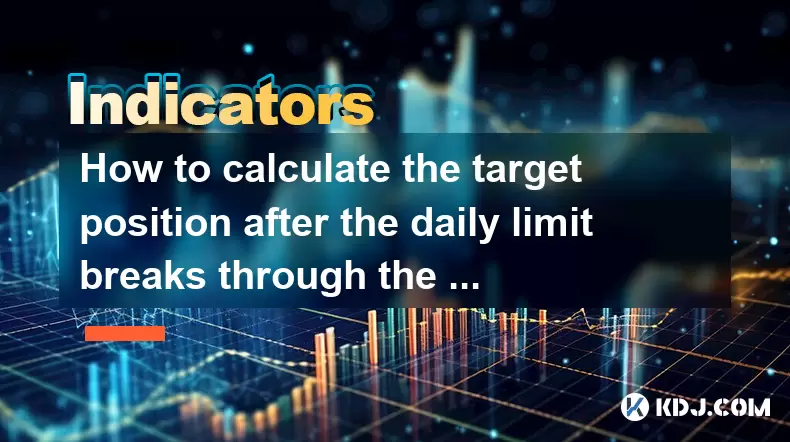
How to calculate the target position after the daily limit breaks through the previous high?
Jun 23,2025 at 02:57pm
Understanding the Daily Limit BreakthroughIn cryptocurrency trading, a daily limit typically refers to the maximum price movement allowed within a single trading day on certain exchanges. When this limit is breached, especially when it surpasses the previous high, traders often seek to calculate the target position or expected price movement following s...
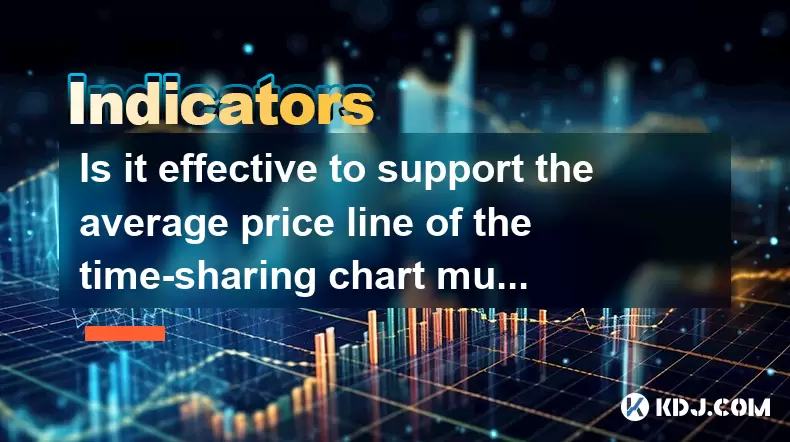
Is it effective to support the average price line of the time-sharing chart multiple times?
Jun 23,2025 at 01:36pm
Understanding the Average Price Line in Time-Sharing ChartsIn cryptocurrency trading, time-sharing charts refer to real-time price charts that display price movements over short intervals, often within a single trading day. Within these charts, the average price line, also known as the Volume Weighted Average Price (VWAP), is a commonly used technical i...
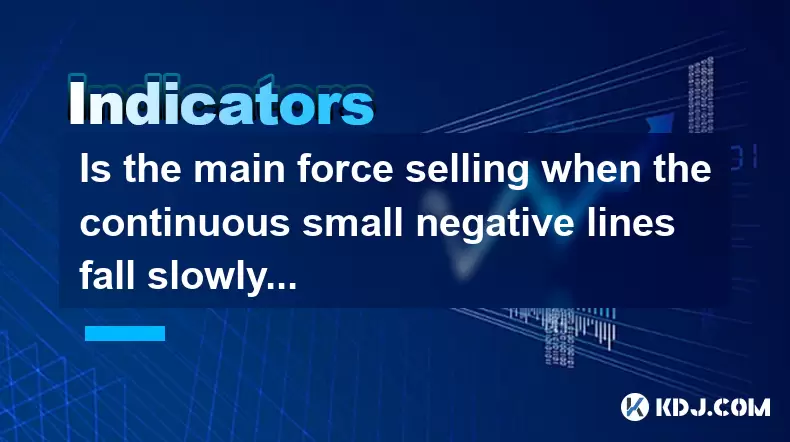
Is the main force selling when the continuous small negative lines fall slowly?
Jun 23,2025 at 03:35pm
Understanding Continuous Small Negative Lines in Cryptocurrency ChartsIn cryptocurrency trading, continuous small negative lines refer to a pattern where the price of an asset declines gradually over time with small bearish candlesticks. These candlesticks typically have short bodies and may or may not have wicks. This pattern often appears during perio...
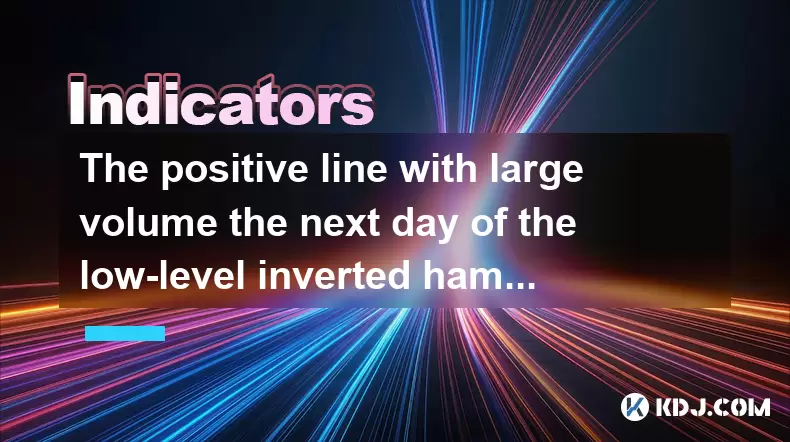
The positive line with large volume the next day of the low-level inverted hammer line confirms the reversal?
Jun 23,2025 at 01:21pm
Understanding the Low-Level Inverted Hammer LineThe inverted hammer line is a single candlestick pattern that typically appears at the end of a downtrend. It has a small real body near the bottom of the trading range and a long upper shadow, indicating that bulls attempted to push prices higher but were met with selling pressure. When this pattern forms...
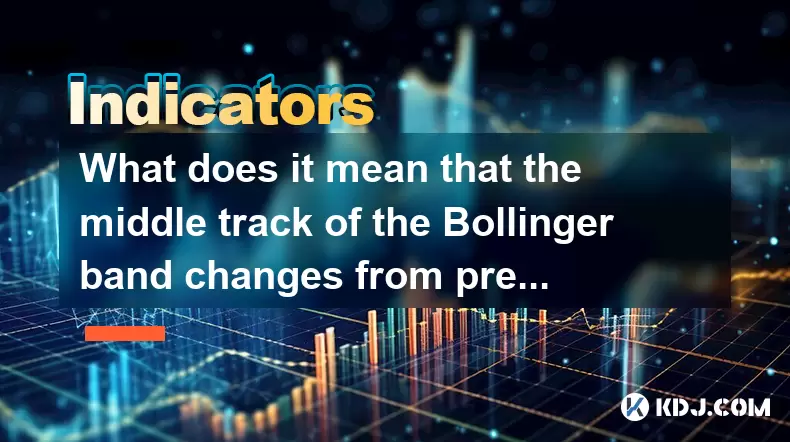
What does it mean that the middle track of the Bollinger band changes from pressure to support?
Jun 23,2025 at 03:01pm
Understanding the Bollinger Band StructureThe Bollinger Bands are a technical analysis tool used in cryptocurrency trading, developed by John Bollinger. They consist of three lines: a simple moving average (SMA) in the middle and two standard deviation bands above and below it. The middle track is typically set at 20 periods and serves as a baseline for...

How to read the sideways consolidation after the bottom volume and long positive line?
Jun 23,2025 at 02:28pm
Understanding the Sideways ConsolidationWhen analyzing cryptocurrency charts, sidewards consolidation refers to a phase where prices move within a narrow range without a clear upward or downward trend. This pattern often appears after significant price movements, such as a sharp increase followed by a period of equilibrium between buyers and sellers. In...

How to calculate the target position after the daily limit breaks through the previous high?
Jun 23,2025 at 02:57pm
Understanding the Daily Limit BreakthroughIn cryptocurrency trading, a daily limit typically refers to the maximum price movement allowed within a single trading day on certain exchanges. When this limit is breached, especially when it surpasses the previous high, traders often seek to calculate the target position or expected price movement following s...

Is it effective to support the average price line of the time-sharing chart multiple times?
Jun 23,2025 at 01:36pm
Understanding the Average Price Line in Time-Sharing ChartsIn cryptocurrency trading, time-sharing charts refer to real-time price charts that display price movements over short intervals, often within a single trading day. Within these charts, the average price line, also known as the Volume Weighted Average Price (VWAP), is a commonly used technical i...

Is the main force selling when the continuous small negative lines fall slowly?
Jun 23,2025 at 03:35pm
Understanding Continuous Small Negative Lines in Cryptocurrency ChartsIn cryptocurrency trading, continuous small negative lines refer to a pattern where the price of an asset declines gradually over time with small bearish candlesticks. These candlesticks typically have short bodies and may or may not have wicks. This pattern often appears during perio...

The positive line with large volume the next day of the low-level inverted hammer line confirms the reversal?
Jun 23,2025 at 01:21pm
Understanding the Low-Level Inverted Hammer LineThe inverted hammer line is a single candlestick pattern that typically appears at the end of a downtrend. It has a small real body near the bottom of the trading range and a long upper shadow, indicating that bulls attempted to push prices higher but were met with selling pressure. When this pattern forms...

What does it mean that the middle track of the Bollinger band changes from pressure to support?
Jun 23,2025 at 03:01pm
Understanding the Bollinger Band StructureThe Bollinger Bands are a technical analysis tool used in cryptocurrency trading, developed by John Bollinger. They consist of three lines: a simple moving average (SMA) in the middle and two standard deviation bands above and below it. The middle track is typically set at 20 periods and serves as a baseline for...
See all articles
























































































